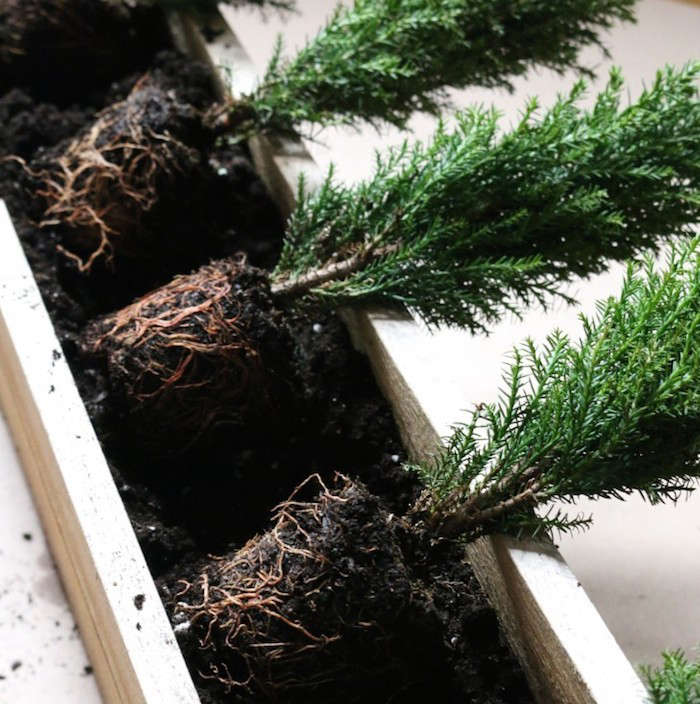Name a construction material–wood, zinc, copper, iron, tin, ceramic, terra cotta, wire–and no doubt someone somewhere has made a window box from it (I once saw beautiful window boxes made out of rubber tote bags). Which one is right for your window?
No matter what you choose, the box should be rot resistant and strong. A wide box filled with plants can weigh hundreds of pounds when soil is wet. Even lightweight soil mixtures designed for containers still require a strong box (don’t forget about those pushy plant roots). A flimsy container will sag and even break under the weight.
We’ve mapped out the pros and cons of common window box materials to make your decision easier.
N.B.: This is the second part of our series on window boxes. Before you choose a material for window boxes, select a style and calculate the proper size. See last week’s Hardscaping 101: Window Boxes to get started.
Wood:
Above: Photograph by Douglas Lyle Thompson for Gardenista.
A traditional and attractive window box material that goes well with most architectural styles, wood is a good choice if you’re building custom sized boxes. Soft woods such as pine are prone to rot. Consider more resistant woods such as cypress, cedar, redwood, and teak. An advantage of wood is that it can be painted. However if water from the soil inside the box saturates the wood, the paint may bubble and peel away. Place a plastic liner inside the box to prevent rot and water damage.
Pros: Attractive. Goes well with most styles of architecture. Can be painted. Can be built to fit any size window.
Cons: Prone to rot and has a shorter lifespan than boxes of other materials unless you add a metal or plastic liner. Vulnerable to insect damage. Heavy.
Above: Bulbs in a wooden window box in Brooklyn. For more on wooden window boxes, check out our post 10 Easy Pieces: Wooden Window Boxes. Photograph by Erin Boyle.
Above: Photograph by Liesa Johannssen for Gardenista.
Terra Cotta:
Above: Before planting in terra cotta boxes, such as the handmade Italian Cassetta Finestra boxes (from £95 to £325 at Italian Terrace), soak them in water. That way they won’t absorb all the water you intend to give your new plants. For more on terra cotta boxes, see Design Sleuth: Terra Cotta Window Boxes.
Terra cotta window boxes are made of unglazed earthenware. They were used by ancient Romans and look fantastic with Mediterranean architecture. However, they tend to be quite pricy and, if you water them in the winter, are prone to crack. Use these if you have space to bring them inside in cold weather or if you are lucky enough to live in a climate that is warm all year. Terra cotta is porous, which means it dries out quickly in hot weather; be prepared to water plants as necessary.
Pros: Beautiful. Breathable. Natural.
Cons: Expensive. Heavy. Can crack in freezing temperatures.
Metal:
Above: Aged Zinc Window Boxes are from £16.50 to £35.95 depending on size from The Balcony Gardener. For more on metal window boxes, check out our post 10 Easy Pieces: Metal Window Boxes.
Window boxes made of aluminum are rust proof and lightweight. Copper is beautiful and forms an attractive patina over time. However, it is extremely expensive. If your windows get bright sun all day, it’s a good idea to avoid dark-colored or solid metal boxes; they will heat up and become ovens that bake plants.
Pros: Will not rot. Not subject to insect damage. Strong and durable. Attractive.
Cons: Prone to dents. Expensive. Rust can be a problem.
Above: Made of 24-gauge steel, a 48-inch-long Galvanized Trough Planter has a slim profile at only 5 inches wide and 4 inches deep. Suitable for indoor or outdoor use, it’s $128 from Terrain.
Composite PVC:
Frequently made of recycled wood products, these are materials that chemically combine wood and plastic. Wood dust or fiber and recycled plastic are common ingredients. Manufacturers claim products made from composite PVC have the attributes of both wood and plastic with none of the drawbacks. In other words, unlike wood they resist water damage, and unlike plastic they are strong.
Pros: Will not rot. Can be painted. Available in many styles.
Cons: Can be expensive.
Fiberglass and Resin:
Above: The resin Eloquence Window Box in a weathered stone finish looks like terra cotta. Starts at $22 (depending on size) at Windowbox Small Space Gardens.
Window boxes made of fiberglass and resin resist moisture damage, are very strong and are lightweight. Available in many styles and shapes, resin boxes often mimic the look of natural materials such as terra cotta but without the weight and fragility. There is a range of material compositions available, some mixing clay, limestone, and other natural substances with fiberglass and resin. They can be painted without the worry that the paint will readily peel. They will not rust or corrode and, with careful handling, are quite durable. Secure mounting is very important because fiberglass resin boxes are so lightweight that they can become flying projectiles in high winds.
Pros: Will not rot. Can be painted. Available in many styles.
Cons: Non-porous so adequate drainage must be ensured. Expensive.
Above: The ResinStone Classic Window Box is available in several finishes, including black; $169 at Amedeo Design.
Ready to plant? Here are some posts that can help: Magic Trick: The Invisible Window Box, DIY Patio Planter: Dark and Stormy Shades and DIY Planters: Tough Beauties.
Above: Plants for your window box can include Tiny Trees to Last All Season. Photograph by Erin Boyle.
Window boxes are a great way to add curb appeal. Michelle has Ten More Ways to Add Curb Appeal for Under $100.

























Have a Question or Comment About This Post?
Join the conversation (2)